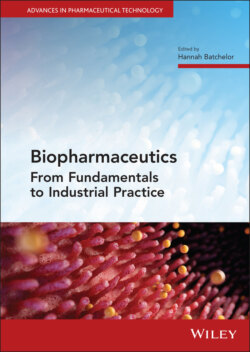Читать книгу Biopharmaceutics - Группа авторов - Страница 50
3.4 Permeability
ОглавлениеFor drug to pass from the exterior of the body to the interior it needs to permeate at least one membrane. Moreover, membrane permeability is also needed for drug distribution and elimination following absorption. Permeability of the drug across the relevant membrane is a key measurement within biopharmaceutics. Measurement of permeability will help understand the rate‐limiting processes associated with absorption and manage risks during the development process.
Permeability is reported as the mass of drug that is transported across a unit area of membrane over a given time. In most cases, the drug needs to be solubilised at the membrane surface in order to permeate the membrane. Yet cellular membranes are formed of lipid bilayers where the core is lipophilic, which can be a barrier to very hydrophilic compounds. This lipid bilayer favours transport of unionised and non‐polar compounds. In permeability modelling the lipid bilayer can be considered to be a homogenous organic layer thus lipidic molecules are preferred.
Figure 3.1 provides an overview of the transport pathways across cells as an example for permeability.
Passive membrane permeation is a concentration gradient driven process that typically follows a first‐order kinetics. Passive transport can be further divided into passive transcellular where the drug is transported through the cell and passive paracellular where the drug permeates the tight junctions between epithelial cells. In passive transcellular permeability there is a correlation between a drug's log P value between log P of −2 to +4 and the rate of transport; where the higher the log P value the greater the permeability [3]. Whilst cationic small molecules are able to permeate the paracellular pathway larger anionic molecules cannot [4]. There is much data on the most suitable animal or cell‐based models to mimic the transcellular permeation observed in humans that is described in Chapter 5.
Figure 3.1 Image of transport pathways across a cellular membrane.
Active transport (also termed carrier‐mediated transport) across a membrane is facilitated by transporters present at either side of the membrane; this can result in net uptake or net efflux of a compound depending on the affinity to the transporter and the relative density of transporters present at the site of absorption. Transporters can also be subject to competitive binding that can lead to drug–drug or drug–nutrient interactions.
